-
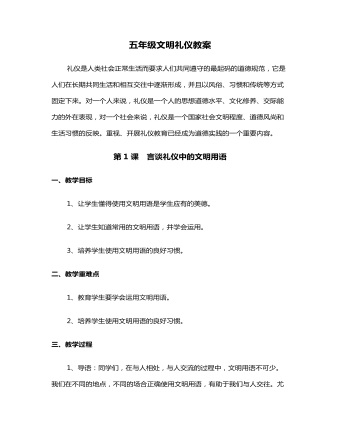
五年级文明礼仪教案
1、导语:同学们,在与人相处,与人交流的过程中,文明用语不可少。我们在不同的地点,不同的场合正确使用文明用语,有助于我们与人交往。尤其是对于我们学生来说,如果经常使用文明用语,那么人人都会喜欢我们,夸奖我们。 2、讲故事:一个年轻人去张村,可他不认识去张村的路。半路上遇见一位老人,年轻人喊道“喂,老头儿,这里离张村有多远?”老头脱口而出:“无礼!”年轻人足足走了五里路,一直没有看见有叫张村的地方。年轻人停下来想了又想,似乎悟出了什么。年轻人的行为给自己带来了什么结果?(小结)什么是礼貌,它与尊重的关系。 你想做个懂礼貌的孩子吗?要想懂礼貌必须先知道什么? 3、学生说出常用的文明语言及使用的场合和对象。(小组讨论,选代表发言) 4、考察情况,即兴表演。同学们说得都很不错,现在我们就来比一比,哪一组是文明礼貌大组。必须认真听老师提出的问题,然后派人表演,表演合格就能领到通行证,得到通行证最多的组就是文明礼貌大组。
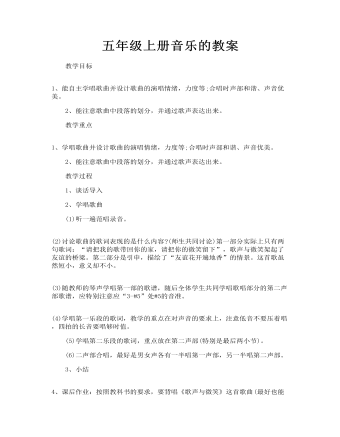
五年级上册音乐的教案
(1)听一遍范唱录音。 (2)讨论歌曲的歌词表现的是什么内容?(师生共同讨论)第一部分实际上只有两句歌词:“请把我的歌带回你的家,请把你的微笑留下”,歌声与微笑架起了友谊的桥梁。第二部分是引申,描绘了“友谊花开遍地香”的情景。这首歌虽然短小,意义却不小。

人教版新课标PEP小学英语五年级上册What Can You Do教案
1、能够听懂、会说:Can you ……?Yes, I can./No, I can’t, but I’d like to have a try!并能在情景中运用。2、能够完成Task time中的任务。教学重、难点:重点:Can you ……? Yes, I can./No, I can’t.难点:I’d like to have a try. 以及在实际情景中正确运用所学对话。课前准备:录音带、录音机、动作词卡教学过程:1、 热身(1) 放歌谣,学生边说边做相应的动作。(2) 将动词编入歌谣,有节奏地说唱。2、 预习(1) 听数字,报词组。(2) 做“少了什么?”游戏。(3) 学生拼读四会词组并仿写。3、 新授Let’s try(1)教师向学生展示挂图,放录音,学生用彩笔连线,完成练习。录音内容如下:①Boy: I can make the bed. I can do the dishes. And I can empty the trash.②Girl: I can sweep the floor. I can cook the meals. I can wash the clothes.Listen and link. Who are they?(2)教师检查并指导学生完成连线。(3)师生、生生问答操练:Can you ……?Yes, I can. /No, I can’t.Let’s talk(1)教师放录音,学生跟读。注意“but I’d like to have a try!”的发音和意思。(2)学生四人小组进行对话操练,然后上台表演对话。(3)请若干女生上台,做连锁问答游戏。
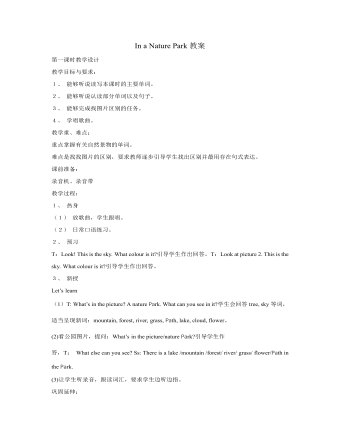
人教版新课标PEP小学英语五年级上册In a Nature Park教案
(3) 听录音,跟读。(4) 同桌之间,进行对话替换操练,然后先几组在班上说一说。(5) 听Let’s check.教师放录音。录音原文如下:Is there a lake in the nature Park?No, there is a river. The water is very clean.Are there any tall buildings in your village?No, there aren’t. There are only small houses.Is there a forest near your village? Yes, there is. There are many beautiful trees. Are there any bridges over the river? Yes, there are two bridges.巩固延伸:做配套练习;做“你猜我答”游戏;做Task time任务第六课时教学设计教学目标与要求:1、 能够听说读写本课句型及单词。2、 能用“There be…”句型介绍山村并描述其特征。教学重、难点:重点掌握句型的书写难点:单词的复数。课前准备:词卡、录音机、录音带教学过程:1、 热身(1) 日常口语练习。(2) 放录音,让学生跟着录音说唱。2、 预习做“拼单词”游戏。3、 新授Read and write(1) 看图,说:There are two pictures. What’s in the pictures? Listen.教师放录音,学生边听边阅读。(2) 学生就不懂的地方提问,教师解答。(3) 放录音,然后指导学生完成练习。(4) 指导学生书写四会句子。
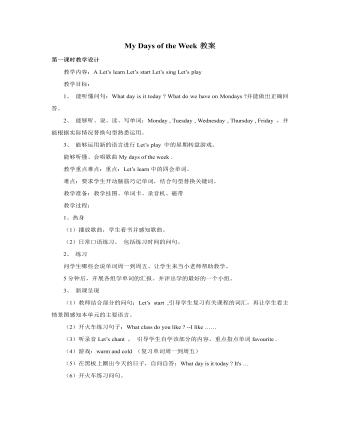
人教版新课标PEP小学英语五年级上册My Days of the Week教案
1、 热身日常口语练习。2、 预习引导学生使用第四课时学过的单词和句型:What do you do on Saturdays? I often do my homework .并结合周末活动的照片复习四会单词和词组,为本课时对话的学习做好准备。3、 新课呈现Let’s try (1)在预习部分操练新词组之后,教师可询问学生的周末安排,然后出示本课时Let’s try部分的挂图,让学生根据挂图说一说这些人物的周末活动,将听与说相结合,适当减缓Let’s try 听力练习的难度。听录音,完成听音圈图的练习。Let’s talk (1)在部分听觉感知新句型的基础上,教师让学生看挂图听录音。(2)跟读对话。Pair work 朗读对话之后,让学生结合自己的实际情况在同桌之间结对交流。Let’s check 播放录音,让学生按照录音内容做练习。第六课时教学设计教学内容:B Read and write Group work C Task time教学目标:能听懂、会说:并能在情景中运用。
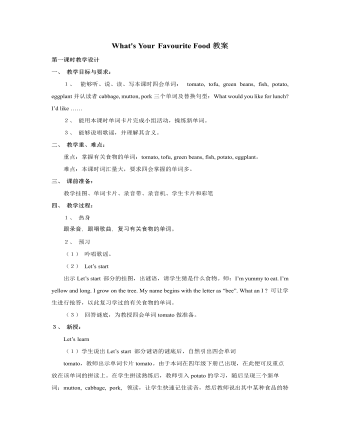
人教版新课标PEP小学英语五年级上册What's Your Favourite Food教案
教读句子:What’s your favourite food?(2)两人小组用该句型编一小段对话进行操练,同时也可引导学生用该句型编一小段对话进行操练,同时也可引导学生用fruit and drink替换food.(3)听录音,让学生跟读对话。学生可用不同的食物单词做替换回答问句。Pair work让学生拿出已发的调查表格,用所学句型对不同学生进行调查,并要求对方陈述原因。先组内汇报,再向全班汇报,汇报时要说出:I like …… Mike likes…… We like……教师看哪一小组表现好,适当给予奖励。Task time请学生拿出第一课时所做的谜语卡片,向全班展示。巩固延伸:做配套练习,读对话给家长听,熟记单词第六课时教学设计教学目标与要求:1、能够听、说、读、写本课时四会句子:What’s your favourite fruit?I like apples. They’re sweet. I don’t like grapes. They’re sour.并能在情景中正确运用。能够在Group work中使用该句型完成调查。2、能够理解情景对话的含义并完成句子填空。3、能够理解Pronunciation中字母组合的发音规则,读出相关的单词。

人教版新目标初中英语九年级下册By the time I got outside, the bus had already left教案
Ⅰ. Teaching Aims and Demands1. Knowledge Objects(1) Key Vocabularyoversleep(2) Target LanguageWhat happened?I overslept. And by the time I got up, my brother had already gotten in the shower.2. Ability Objects(1) Teach the students to use the new words.(2) Train the students to narrate past events with the Past Perfect Tense.(3) Train the students' listening and speaking skills with the target language.3. Moral ObjectIt’s a good habit to go to bed early in the evening and get up early in the morning. So you’ll never be in a hurry in the morning.Ⅱ. Teaching Key Points1. Key Vocabularyoversleep2. Target LanguageNarrate past events with the Past Perfect TenseⅢ. Teaching Difficult Points1. Train the students to narrate past events with the Past Perfect Tense.2. Train the students to understand the target language in spoken conversation.Ⅳ. Teaching Methods1. Thinking of examples from the students' real lives.2. Making sentences by looking at the pictures.Ⅴ. Teaching AidA tape recorderⅥ. Teaching ProceduresStep I Revision1. Revise the language points in Unit 8.Ask some questions like this: What volunteer work would you like to do?Help the students to answer, I’d like to…/I love to…/I hope to2. Practice the dialogue in Activity 3c on page 62 again. Get students to role play the similar dialogues with the following.

人教版新目标初中英语九年级下册We’re trying to save the manatees教案2篇
本单元主要围绕着有关濒临灭绝的动物这一话题,学习了应该怎样保护我们的环境,以及就某一问题展开辩论。目标提示语言目标能够运用所学知识,就某一问题展开辩论。认知目标1、复习一些语法:现在进行时、一般现在时、用used to 表示一般过去时、现在完成时、一般过去时的被动语态。2、学会表达同意和不同意。3、学会以下基本句型:We’re trying to save the manatees.Manatees eat about 100 pounds of food a day.There used to be a lot of manatees.In 1972,it was discovered that they were endangered.Some of the swamps have become polluted.情感目标了解一些濒临灭绝的动物的生活习性和濒临灭绝的原因,教育学生应该如何保护环境。教学提示充分利用多媒体等教学设备,创设与本课话题相关的情境,如各种不同种类的动物、动物园以及有关环境的画画等等。围绕着本单元的教学目标,设计一些贴近学生实际的教学任务,如让学生谈论自己最喜欢的动物,如何拯救濒危动物,如何保护环境等等。让学生根据所学知识,就动物园是否对动物有利以及其他的话题进行辩论。

人教版新目标初中英语九年级下册You’re supposed to shake hands教案
教学目标:1. 掌握本单元一些重点词汇的写法和用法。2. 学会自如谈论餐桌礼仪。Step 1 RevisionAsk some students to retell the customs at the table in France in the passage in 3a.Step 2 Self checkPart 1. Fill in each bland with the correct word given. Students do the exercises by themselves at first. Then check the answers. Ask the students to comprehend the sentences and help them point out uses of some words, like “arrive (at / in) sw., spend time / money on sth , spend time / money (in) doing sth.”Part 2. Read about Fan Ling’s experience in a western restaurant. Understand the passage. Point out some key points in the passage.1. be / get used to doing sth. 习惯做某事2. begin with = start with 以….开头3. crowd v. 挤满,塞满 the crowd 人群 crowded adj. 拥挤的Then students discuss about how she would solve her problem. Ask some to share their stories with others.Part 3. Complete the crossword by looking at the sentences on the left. Then check the answers.

人教版新目标初中英语九年级下册Rainy days make me sad教案
1. 教材分析本单元以how do things affect you?为话题, 从颜色、天气、音乐、广告、产品等方面谈论了外界事物如何影响人的心情。要求学生掌握表达某物或某事给人带来的感觉、看法或影响等。共设计了四个部分的内容:Section A 该部分有4个模块:第一模块围绕Which restaurant would you like to go to?这一话题展开思维(1a)、听力(1b)、口语(1c)训练;第二模块围绕How does music affect you? 进行听力(2a-2b)、口语训练(2c);第三模块继续围绕how do colors in the restaurant affect you这一话题展开训练,训练形式为阅读和问题体验(3a)和小组活动(3b);第四模块仍就How do things affect you这一话题以调查的形式展开讨论。Section B该部分有4个模块:第一模块围绕产品广告对人们的影响这一话题以“配对”(1a)与“列举”(1b)两种形式展开训练;第二模块继续围绕How do things affect you? 进行听力(2a-2b)、口语对话训练(2c);第三模块围绕“Advertising”这一话题展开阅读(3a-3b)和写作(3c)训练;第四模块围绕How posters affect you这一话题以口语训练形式展开小组活动。

人教版新目标初中英语九年级下册Could you please tell me where the restrooms are教案
Step Ⅰ RevisionCheck homework. Ask a few students to read the article in 3a.Then ask a few students to read their guides.Step Ⅱ Part 1Look at the words in the box. Ask a student to read them. Make sure the students understand the meaning of the words. You are to fill in the blanks with the words. In some cases, students may need to use another form of the word, for example adjusting for tense or subject/ verb agreement.Ask students to fill in the blanks on their own.Check the answers. Step ⅢPart 2Go through the instructions with the class.Look at the example with the students.Ask students what the answer would be.Ask a student to read the question and answer it.Excuse me, could you tell me where the bank is, please?The bank is across the street from the shopping malt.Get students to complete the work in pairs.Check the answers. Ask a few students to read their questions.Step Ⅳ Just for Fun!Ask all the students to read the conversation. Ask: What is funny about this cartoon? Help students to explain. A Martian is a person from the planet Mars.There is no such thing as Martian food on Earth, and the clerk looks silly because he is trying to think of where there is a Martian restaurant.Invite some pairs of students to present this conversation to the rest of the class.Step Ⅴ Summary and HomeworkIn this class, we’ve done much writing practice using the key vocabulary words and the target language presented in this unit. After class, please finish the questions in 2 in your exercise books. Then finish the exercises on pages 47~48 of the workbook as well.The Seventh Period Ⅰ Teaching Aims and Demands1. Knowledge Objects(1) Key Vocabularyimage, adventure, jealousy, hero, crime, journey, brave, no longer, show interest in, take it easy, become interested in, plain looks(2)Text:Grown-ups like cartoons, too.2. Ability Objects(1) Fast-reading to get a general idea of the text.(2) Careful-reading to get the detailed information in the text.

人教版新目标初中英语九年级下册I’ll help clean up the city parks教案
Talk about offering help (P60)I’ll help clean up the city parks.A: I’d like to work ...B: You could help ...Talk about ways to tell people about the Clean-Up Day (P61)We need to ...We can’t ...I’ll ...Talk about the work the volunteers do (P62)These three students all volunteer their time to help other people.Somebody loves to ... / helps ... / plans to ... / wants to ...A: What do you like doing?B: I like ... A: What kind of volunteer work do you think I could do?B: You could ...1. 重点词汇advertisement, fix, repair, pleasure, blind, deaf, shut, carry, specially, fetch2. 认读词汇hunger, homeless, cheer, clean-up, sign, establish, major, commitment, elementary, veterinarian, coach, similar, call-in, strategy, disabled, organization, unable, support, appreciate, donation, part of speech, pronoun, adverb, preposition, conjunction, donate, Jimmy, Sally3. 词组clean up, cheer up, give out, put off, set up, think up, take after, fix up, give away, put up, hand out, work out, at once
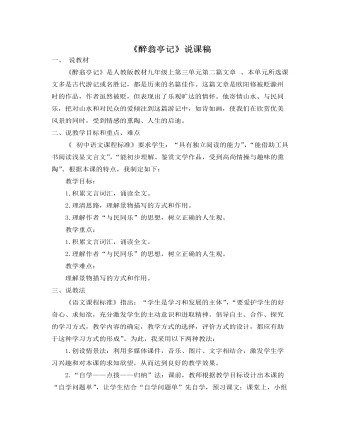
部编版语文九年级上册《醉翁亭记》说课稿
1.创设情景法:利用多媒体课件,音乐、图片、文字相结合,激发学生学习兴趣和对本课的求知欲望,从而达到良好的教学效果。2.“自学——点拨——归纳”法:课前,教师根据教学目标设计出本课的“自学问题单”,让学生结合“自学问题单”先自学,预习课文;课堂上,小组合作讨论、解疑,教师适时点拨,最后归纳,逐步解决“自学问题单”中的问题,从而完成“教学目标”中的任务。四、说学法郭沫若先生曾说读书要“用自己的头脑来想,用自己的眼睛来看,用自己的手来做”。《语文课程标准》也特别强调:语文课程必须面向全体学生,使学生获得基本的语文素养,自主、合作、探究的学习方式应得到积极的提倡。九年级学生经过两年的初中学习后,已基本形成了一定的学习方法,也已经有了自主意识和自主学习的能力,所以,我采用了“自主、合作、探究”的学习方式。
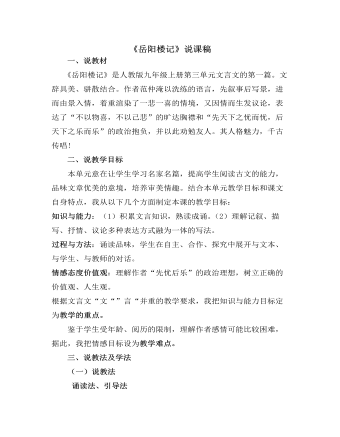
部编版语文九年级上册《岳阳楼记》说课稿
一、说教材《岳阳楼记》是人教版九年级上册第三单元文言文的第一篇。文辞具美、骈散结合。作者范仲淹以洗练的语言,先叙事后写景,进而由景入情,着重渲染了一悲一喜的情境,又因情而生发议论,表达了“不以物喜,不以己悲”的旷达胸襟和“先天下之忧而忧,后天下之乐而乐”的政治抱负,并以此劝勉友人。其人格魅力,千古传唱!二、说教学目标本单元意在让学生学习名家名篇,提高学生阅读古文的能力,品味文章优美的意境,培养审美情趣。结合本单元教学目标和课文自身特点,我从以下几个方面制定本课的教学目标:知识与能力:(1)积累文言知识,熟读成诵。(2)理解记叙、描写、抒情、议论多种表达方式融为一体的写法。过程与方法:诵读品味,学生在自主、合作、探究中展开与文本、与学生、与教师的对话。
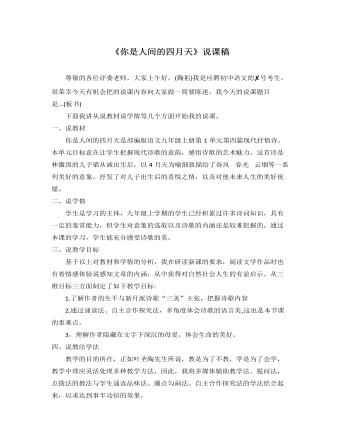
部编版语文九年级上册《你是人间的四月天》说课稿
三、说教学目标基于以上对教材和学情的分析,我在研读新课的要求,阅读文学作品时也有着情感体验说感知文章的内涵,从中获得对自然社会人生的有益启示。从三维目标三方面制定了如下教学目标:1.了解作者的生平与新月派诗歌“三美”主张,把握诗歌内容2.通过诵读法、自主合作探究法,多角度体会诗歌的语言美,这也是本节课的重难点。3,理解作者隐藏在文字下深沉的母爱,体会生命的美好。四、说教法学法教学的目的所在,正如叶圣陶先生所说,教是为了不教,学是为了会学,教学中理应灵活处理多种教学方法,因此,我将多媒体辅助教学法、提问法,点拨法的教法与学生诵读品味法、圈点勾画法、自主合作探究法的学法结合起来,以求达到事半功倍的效果。
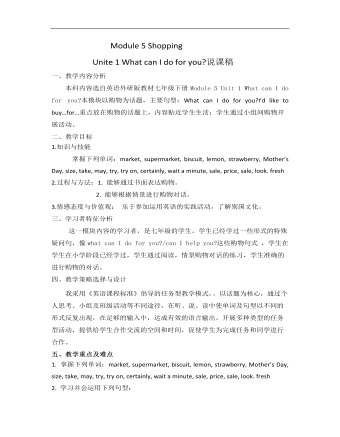
初中英语外研版七年级下册《Module 5 Shopping》说课稿
二、教学目标1.知识与技能掌握下列单词:market, supermarket,biscuit, lemon, strawberry, Mother’s Day, size, take, may, try, try on,certainly, wait a minute, sale, price, sale, look. fresh2.过程与方法:1. 能够通过书面表达购物。2. 能够根据情景进行购物对话。3.情感态度与价值观:乐于参加运用英语的实践活动,了解别国文化。三、学习者特征分析这一模块内容的学习者,是七年级的学生。学生已经学过一些形式的特殊疑问句,像what can I do for you?/can I help you?这些购物句式 ,学生在学生在小学阶段已经学过,学生通过阅读,情景购物对话的练习,学生准确的进行购物的对话。
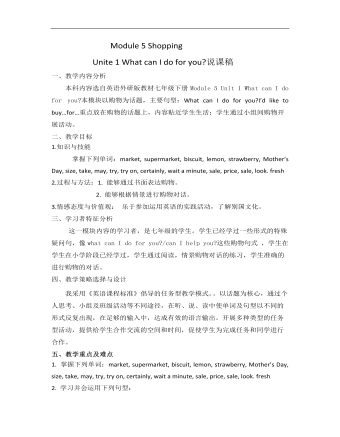
初中英语外研版七年级下册《Module 5 Shopping》说课稿
二、教学目标1.知识与技能掌握下列单词:market, supermarket,biscuit, lemon, strawberry, Mother’s Day, size, take, may, try, try on,certainly, wait a minute, sale, price, sale, look. fresh2.过程与方法:1. 能够通过书面表达购物。2. 能够根据情景进行购物对话。3.情感态度与价值观:乐于参加运用英语的实践活动,了解别国文化。

北师大初中数学八年级上册从统计图分析数据的集中趋势1教案
1.能从统计图中获取信息,并求出相关数据的平均数、中位数、众数;(重点)2.理解并分析平均数、中位数、众数所体现的集中趋势.(难点)一、情境导入某次射击比赛,甲队员的成绩如下:(1)根据统计图,确定10次射击成绩的众数、中位数,说说你的做法,并与同伴交流.(2)先估计这10次射击成绩的平均数,再具体算一算,看看你的估计水平如何.二、合作探究探究点一:从折线统计图分析数据的集中趋势广州市努力改善空气质量,近年空气质量明显好转,根据广州市环境保护局公布的2006~2010年这五年各年的全年空气质量优良的天数,绘制成折线图如图所示.根据图中信息回答:(1)这五年的全年空气质量优良天数的中位数是________;(2)这五年的全年空气质量优良天数与它前一年相比较,增加最多的是________年(填写年份);(3)求这五年的全年空气质量优良天数的平均数.解析:(1)由图知,把这五年的全年空气质量优良天数按照从小到大的顺序排列为:333,334,345,347,357,所以中位数是345;
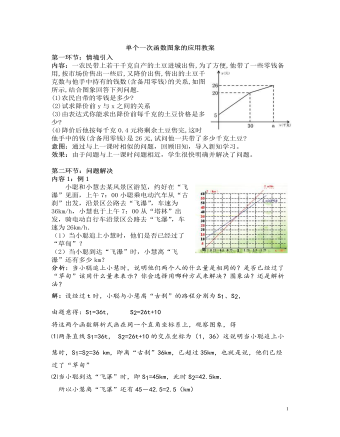
北师大初中数学八年级上册单个一次函数图象的应用2教案
(1)用简洁明快的语言概括大意,不能超过200字;(2)图表中能确定的数值,在故事叙述中不得少于3个,且要分别涉及时间、路和速度这三个量.意图:旨在检测学生的识图能力,可根据学生情况和上课情况适当调整。说明:练习注意了问题的梯度,由浅入深,一步步引导学生从不同的图象中获取信息,对同学的回答,教师给予点评,对回答问题暂时有困难的同学,教师应帮助他们树立信心。第四环节:课时小结内容:本节课我们学习了一次函数图象的应用,在运用一次函数解决实际问题时,可以直接从函数图象上获取信息解决问题,当然也可以设法得出各自对应的函数关系式,然后借助关系式完全通过计算解决问题。通过列出关系式解决问题时,一般首先判断关系式的特征,如两个变量之间是不是一次函数关系?当确定是一次函数关系时,可求出函数解析式,并运用一次函数的图象和性质进一步求得我们所需要的结果.
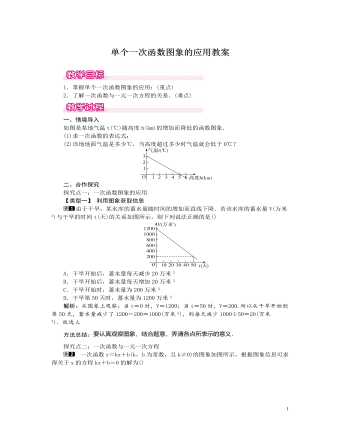
北师大初中数学八年级上册单个一次函数图象的应用1教案
方法总结:要认真观察图象,结合题意,弄清各点所表示的意义.探究点二:一次函数与一元一次方程一次函数y=kx+b(k,b为常数,且k≠0)的图象如图所示,根据图象信息可求得关于x的方程kx+b=0的解为()A.x=-1B.x=2C.x=0D.x=3解析:首先由函数经过点(0,1)可得b=1,再将点(2,3)代入y=kx+1,可求出k的值为1,从而可得出一次函数的表达式为y=x+1,再求出方程x+1=0的解为x=-1,故选A.方法总结:此题主要考查了一次函数与一元一次方程的关系,关键是正确利用待定系数法求出一次函数的关系式.三、板书设计一次函数的应用单个一次函数图象的应用一次函数与一元一次方程的关系探究的过程由浅入深,并利用了丰富的实际情景,增加了学生的学习兴趣.教学中要注意层层递进,逐步让学生掌握求一次函数与一元一次方程的关系.教学中还应注意尊重学生的个体差异,使每个学生都学有所获.

